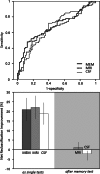MRI and cerebrospinal fluid biomarkers for predicting progression to Alzheimer's disease in patients with mild cognitive impairment: a diagnostic accuracy study
- PMID: 23794572
- PMCID: PMC3686215
- DOI: 10.1136/bmjopen-2012-002541
MRI and cerebrospinal fluid biomarkers for predicting progression to Alzheimer's disease in patients with mild cognitive impairment: a diagnostic accuracy study
Abstract
Objectives: To assess the incremental value of MRI and cerebrospinal fluid (CSF) analysis after a short memory test for predicting progression to Alzheimer's disease from a pragmatic clinical perspective.
Design: Diagnostic accuracy study in a multicentre prospective cohort study.
Setting: Alzheimer Disease Neuroimaging Initiative participants with complete data on neuropsychological assessment, MRI of the brain and CSF analysis.
Participants: Patients with mild cognitive impairment (MCI; n=181) were included. Mean follow-up was 38.9 months (range 5.5-75.9).
Main outcome measures: Diagnostic accuracy of individual instruments and incremental value of entorhinal cortex volume on MRI and p-τ/Aβ ration in CSF after administration of Rey's Auditory Verbal Learning Memory Test are calculated and expressed as the 'Net Reclassification Improvement' (NRI), which is the change in the percentage of individuals that are correctly diagnosed as Alzheimer or non-Alzheimer case.
Results: Tested in isolation, a short memory test, MRI and CSF all substantially contribute to the differentiation of those MCI patients who remain stable during follow-up from those who progress to develop Alzheimer's disease. The memory test, MRI and CSF improved the diagnostic classification by 21% (95% CI 15.1 to 26.9), 22.1% (95% CI 16.1 to 28.1) and 18.8% (95% CI 13.1 to 24.5), respectively. After administration of a short memory test, however, the NRI of MRI is +1.1% (95% CI 0.1 to 3.9) and of CSF is -2.2% (95% CI -5.6 to -0.6).
Conclusions: After administration of a brief test of memory, MRI or CSF do not substantially affect diagnostic accuracy for predicting progression to Alzheimer's disease in patients with MCI. The NRI is an intuitive and easy to interpret measure for evaluation of potential added value of new diagnostic instruments in daily clinical practice.
Keywords: Alzheimer; Mild cognitive impairment; Net reclassification improvement; diagnostic accuracy.
Figures


References
-
- Dubois B, Feldman HH, Jacova C, et al. Research criteria for the diagnosis of Alzheimer's disease: revising the NINCDS-ADRDA criteria. Lancet Neurol 2007;6:734–46 - PubMed
-
- Dubois B, Feldman HH, Jacova C, et al. Revising the definition of Alzheimer's disease: a new lexicon. Lancet Neurol 2010;9:1118–27 - PubMed
Grants and funding
LinkOut - more resources
Full Text Sources
Other Literature Sources
Molecular Biology Databases
